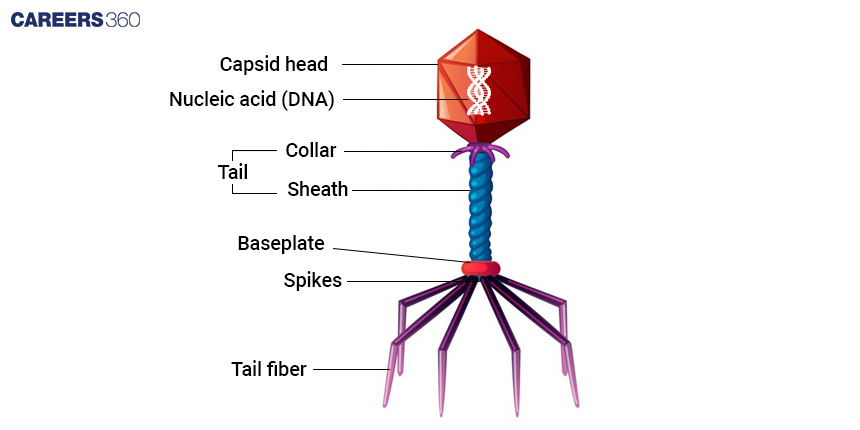bacterial viruses: Overview, structure, examples, Causes, Symptoms, Treatment
Bacterial viruses, also known as bacteriophages or phages, are viruses with the ability to replicate and infect specific targets within bacterial cells.
Definition Of Bacterial Viruses
Bacteriophages are viruses that invade bacterial cells to replicate, which play a very important role in microbial ecology and biotechnology. They are formed by genetic material—either DNA or RNA—encased within a protein coat. They have evolved diverse mechanisms to infect bacteria, either by lysis or through the integration of viral genetic material into the bacterial genome.
NEET 2025: Mock Test Series | Syllabus | High Scoring Topics | PYQs
NEET Important PYQ's Subject wise: Physics | Chemistry | Biology
New: Meet Careers360 B.Tech/NEET Experts in your City | Book your Seat now
- Definition Of Bacterial Viruses
- Structure Of Bacteriophages
- Bacteriophage Reproduction Cycle
- Host Specificity And Attachment Mechanism
- Applications Of Bacteriophages
- Evolution And Diversity Of Bacteriophages
- Challenges And Limitations In Phage Research

The historical background of bacteriophages dates back to the beginning of the 20th century when their existence on Earth was first identified and thereafter highly developed by scientists like Frederick Twort and Félix d'Hérelle. Their discovery opened the avenue to understanding the viral interaction with bacteria and their applications in controlling bacterial infection and manipulating microbial communities.
Structure Of Bacteriophages
The morphology of the bacteriophages, also known as phages, is presented in a rather organised way to infect bacterial hosts. They are mostly defined as composed of a protein capsid that encapsulates their genetic material either in the form of DNA or RNA. The given capsid is normally icosahedral or helical in shape, thus protecting the viral genome while it is being transmitted into host cells.
The genetic material of the phage is contained in the head, or capsid, and is encapsulated by proteins. Attached to the head is the tail—a tubular structure that enables attachment to bacterial cell receptors and facilitates the injection of genetic material into the host. Tail fibres extend from the base of the tail and help to recognise the host and provide attachment specificity that initiates the infection process.
Diagram Of A Bacteriophage
The diagram given below shows the various components of a bacteriophage.

Bacteriophage Reproduction Cycle
In its lytic cycle, the bacteriophages attach themselves to receptors on the surface of the bacterial cells through their tail fibres and subsequently inject their genetic material into the host cell's cytoplasm. Following the entry into the host cell, the phage takes over the cell apparatus to replicate its DNA or RNA genome and synthesise the viral components. This ultimately leads to the assembly of new phage particles. Finally, it causes host cell lysis; from which progeny phages are released to infect other nearby bacteria and start a new cycle.
On the other hand, in the lysogenic cycle, the phage integrates its genetic material in the chromosome of the bacterium or replicates it as a plasmid (nuclear division) inside the host cell and does not cause immediate lysis of the cell. This phage DNA integrated into the chromosome is termed a prophage. The prophage replicates when the host cell's DNA replicates during cell division. Due to environmental stress or host factors, the prophage can excise from the bacterial chromosome and enter into a lytic cycle, resulting in cell lysis and the release of new phages.
Host Specificity And Attachment Mechanism
Host specificity in bacteriophages is a mode of infection where the former only affects specific species or strains of bacteria. This specificity in pathogen focusing is made possible by viral proteins that bind to host cell receptors. This will ensure that bacteria are targeted effectively in various applications, such as phage therapy against antibiotic-resistant strains.
In the mechanism of attachment, viral proteins bind to specific receptors on the surface of a bacterium to initiate infection. This step of recognition is important in phage–host interaction, and this underlies therapeutic efficacy as well as fuels investigations into tailored treatments based on phages.
Applications Of Bacteriophages
They have medical applications in phage therapy against antibiotic-resistant infections. In biotechnology, enabling phage display technology is used in protein engineering and the development of drugs. They are used in agricultural and environmental functions by infecting bacterial pathogens in crops and water sources, therefore offering very sustainable alternatives to chemicals.
Evolution And Diversity Of Bacteriophages
The extreme genetic diversity is coupled with evolutionary adaptations that echo their co-evolutionary dynamics with the bacterial hosts. Evidence for this exists in several bacteriophage families, such as Myoviridae, Podoviridae, and Siphoviridae—all differentiated by morphology, genome structure, and infection strategy. Such evolutionary adaptations allow bacteriophages to survive under different conditions and play crucial roles in microbial ecology, biotechnology, and potential therapeutic applications against bacterial infections.
Challenges And Limitations In Phage Research
Obstacles to phage research include mechanisms of bacterial resistance. Bacteria develop defences against the phages, consequently decreasing their therapeutic and biocontrol applicability. The safety of phage therapy and standards of efficacy, with a clear need for guidelines that are to be developed to ensure responsible use in the clinic—despite their promising potential against antibiotic-resistant bacteria.
Conclusion
Bacterial viruses, or simply bacteriophages, play a crucial role in microbial ecology, biotechnology, and probably some therapies, including even phage therapy. Their importance is underpinned by the fact that they allow specific targeting of certain strains of bacteria. Their field of applications in medicine, agriculture, and environmental management is very wide. As far as prospects are concerned, it could be further investigated to gain a deeper insight into phage biology or by any evasion of the resistance mechanisms of the host bacteria. More extended applications in new treatments and sustainable technologies ensure the interesting development of bacteriophage research and applications.
Frequently Asked Questions (FAQs)
Bacterial viruses, otherwise known as bacteriophages, are viruses that infect and replicate in bacterial cells, impacting bacterial populations and ecosystems.
Bacteriophages attach to certain receptors on the surface of host bacteria through their tail fibres or other proteins, inject their genetic material into the host cell, and hijack the host machinery to replicate.
In the lytic cycle, replication of bacteriophages starts immediately after infection of the host cell, thus finally leading to lysis of the cell with the release of the new viruses. The lysogenic cycle is characterized by the integration of phage DNA into the bacterial chromosome and it remains dormant for the required amount of time before being activated to enter into the lytic cycle consequently.
Bacteriophages are used to treat all kinds of antibiotic-resistant bacterial infections with the help of phage therapy and are being explored as the means to replace or augment traditional antibiotics.
In the case of biotechnology, phages are used in phage display technology for protein engineering and drug development. On the other hand, their application for biocontrol against bacterial plant pathogens and animal diseases is important in agriculture for the provision of sustainable solutions to disease management.
Also Read
30 Nov'24 12:23 PM
28 Nov'24 05:34 PM
25 Nov'24 05:18 PM
23 Nov'24 10:02 AM
22 Nov'24 01:59 PM
21 Nov'24 04:58 PM
16 Nov'24 01:58 PM